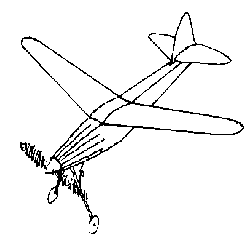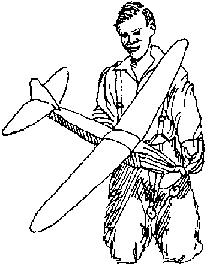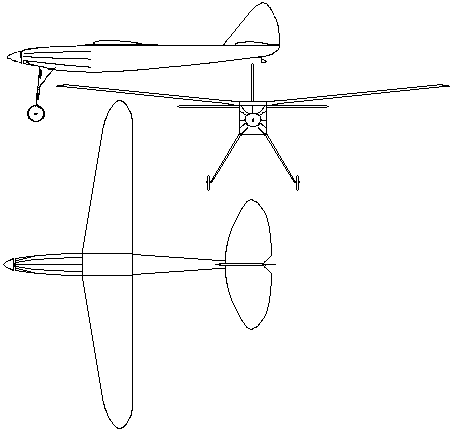Wakefield International Cup - A history from 1911 by Charles Dennis Rushing
1936 Albert A Judge, 19, GB
The venue for the 1936 Wakefield Cup Contest was Detroit, Michigan, to be held following the "USA Nationals", which was scheduled from June 30, to July 2. Among the 400 Contestants competing at the "Nationals" were six members of Team Great Britain who promised in a letter to Frank Zaic "...to take home not only the Wakefield Cup, but the Moffett Trophy, as well". These audacious braggarts were; Alwyn Greenhalgh, age 13, H A Jones age 13, D Fairlie aged 18, Robert Copland, age 18, Albert Judge, age 19, and the oldest at age 33, the wisest, and the 1934 Wakefield Cup Champion J B Allman. Upstarts all, if you ask me! Really, this was a most impressive Wakefield Team, as history will show. They did not get away with the Moffett Trophy, that was lost by proxy flyer Bert Pond, who recorded a 44 minute, 14 second three flight total with Vernon B Gray's cabin model giving New Zealand the Moffett Trophy for the first time. Pond later described himself as " ...the snake in the grass!"
June 30, 1936, was the day of the USA Team eliminations, traditionally held on the last day of the "Nationals". The Team USA members were: The 1932, and 1935 Wakefield International Cup Champion Gordon S Light, Lebanon Penn; Roy Wriston, Tulsa, Oklahoma; Dick Everett, Elm Grove, W V; Bill Atwood, Glendale, California; John Ginnetti, Atlantic City, NJ. The alternates were Charles Tracy, and James Cahill, flying a Wakefield with a folding propeller, this was a first to be shared with Wally Simmers, who independently was also using a folding propeller on his rubber cabin model. Roy Wriston in winning his place on the Team set a new U.S. Record, with one flight of 41 minutes, 10 seconds, which was bettered by Chester Lanzo, the next day with a Class D Cabin flight of 48 minutes, 45 seconds! A record that still stands today. Lanzo's D Cabin was in fact a Wakefield. Controversy still rages over the fact that the stabilizer was larger then 33% of the wing area, which was 210 sq.ins. In July 1986 AeroModeller stated that the SMAE still was unable to confirm an accurate interpretation of their own 1933 - 1936 Rules!
Meanwhile at the Canadian Wakefield Team Eliminations the following persons were selected to represent their nation at the 1936 Wakefield International Cup Contest: Thomas G Harris, Fred Hollingsworth, Melvin Bardsley, Henry Yerdier, Paul Verdier, Raymond T Smith, and John Lemick. From Paris, France was Andre Vincre whose Wakefield next year would be published in AeroModeller as: "THE 1937 WAKEFIELD CUP WINNER". Andre brought with him Team France Wakefields to be flown by the Proxy Team. These included G Dubois, whose proxy was Brown, and Henri Varache, whose proxy was none other than Chester Lanzo. There were Wakefields from, New Zealand, including W G Alexander (p. Marchi), A Pearce (p. Bert Pond), H J Robinson (p. Lanzo), W B Mackley (p. Jim Cahill ), J Finlayson (p. Chadwick), R MacGregor (p. Hoyse ). And Team Canada. Frank Zaic wrote about the "1936 Nationals" in the Junior Aeronautics Year Book of 1934 ( ! ) ,but although he was there, he did not write one word about the 1936 Wakefield International Cup Contest! Only the results!
Wednesday, July 2, 1936 dawned hot, humid, and calm, near Detroit, Michigan at the Wayne County Airport, the venue for the 1936 Wakefield International Cup contest. Assistance was provided by the US Army Air Corps, using Pilot Training Air Cadets as Official Timers, two for each contestant. The SMAE Wakefield International Cup Rules were presented by Team Great Britain and using their advise the Air Cadets scrutinized all of the Wakefields which had been entered for conformance with the Wakefield Rules. A point was made about pushing as was observed "numerous times" at the USA Team eliminations, the previous day. Though how one could push by holding the extreme tip of the wing, and the tip of the propeller is something of a mystery, with a rubber powered aeromodel fully wound to maximum turns, held in the required position, pushing would be a neat trick even for the Great Harry Houdini! There was a draw, and, Albert Judge was selected to have the first flight of the day.
He later recalled that on boarding the train at Waterloo Station, London, it dawned on him that he had left his airscrew on the mantle at home! No problem. His mother would drive home, retrieve the airscrew from the mantel, and meet the Team at the docks. She arrived just in the nick of time, as Albert and the Team were heading up the ramp to board the ship SS Aquitania.
ROUND 1: Now Albert concentrated upon packing 1200 turns onto his rubber motor. Done. Albert placed his Wakefield in the proper ROG position on the take-off board, and let go! It was away! Climbing steeply, but straight under torque, then right, holding steady to the side thrust. Power off, the propeller free wheeled into the glide pattern, circling left in 200 yard circles. Flying OOS in 497 seconds, but with the Air Cadets in pursuit in their "Jeep". The Air Cadet Chase Team, was efficient because they stayed with Albert's Wakefield until it landed, and returned to the flying field with his plane undamaged. The defending Wakefield Champion Gordon S Light had a flight of 283.5 seconds, he was second. Denis Fairlie with 276.3 was third. Bob Copland was fourth, with 275.2 seconds, and the 1934 Wakefield Champion J B AIlman with 270.8 was fifth. Dick Everett with 270.0 was sixth, and John Ginnetti with 246.2 was seventh. Bill Atwood was eighth with 105.0 seconds, Andre Vincre was ninth, with 92.5 seconds, Roy Wriston was tenth with 100.0 seconds, and G. Dubois (p. Brown) was eleventh with 80.0 seconds. The ambient temperature was now over 90 degrees Fahrenheit.
ROUND 2: Albert Judge kept his fresh rubber motors in a thermos. He quickly exchanged the used motor, and stuffed a new one into his fuselage. Then he proceeded to pack in the turns, for his second flight. At 950 turns this motor crystallized, and shredded the uprights of his fuselage! Meanwhile Roy Wriston had a 555 second flight to take the lead with 655 seconds. Bert Judge was ready again, putting only 900 turns into his motor he did 136.2 seconds for a 633 total time, dropping to second place. Dick Everett jumped into third place with a 221.4 second flight, for a two round total of 571.3 seconds! Bob Copland showing consistency came in with 130.9, for a two round total of 406.1 seconds, for fourth place. Gordon light had a 103 second flight, and was now fifth with 396.5 seconds. J B Allman continued his championship form with a 149.0 second flight, for a total of 299.8 seconds to hold sixth place. Denis Farlie was seventh with a 296.5 total, Bill Atwood eighth 221.0 seconds, John Ginnetti ninth 210.3 seconds, tenth Dubois 190.0 seconds, and eleventh Andre Vincre 179.5 seconds. Now not only the temperature was rising, but so were the frayed tempers of the leaders. Any of the ten could take "The Cup".
ROUND 3: Roy Wriston had lost his Wakefield. He searched frantically down wind, with some Air Cadets who helped him look for it. Bert Judge decided to use the same rubber motor he had used on his second flight. Al also decided to play it safe by limiting his winds to 850 turns in the by now 100 degree heat. At 845 turns the motor burst again, the pieces shredded the fuselage with the surgical precision of a hatchet! Bert was probably frantic, his hands may have trembled as he rebuilt his Wakefield. Bob Copland scored a 205.2 second flight, with J B Allman behind him with 190.1 seconds! Where was Wriston? Time was running out!
Judge was ready again, and this time using a cool motor from his thermos, he stopped winding at 800 turns, taking no chances. Now he was set, and away! Judge was down in only 116.3 seconds; landing as Roy Wriston climbed out of the "Jeep" with his lost, but now found Wakefield. Quick calculations indicated that Wriston could win it all with a flight of only 158.1 seconds, to beat Judge! The wing of Wriston's Wakefield had to be repaired, but there wasn't enough time. Electing to forget the repairs, Roy began winding. At 750 turns he was at the nose block! Now without hesitation he grasped what was left of his right wing, held the tip of the propeller, closely watched by the English Team Manager B K Johnson, who was clutching the "Lucky Mascot" given to him by Mrs Thurston aboard the Aquitania. Roy let go of the remains! It climbed off the take-off board, but was shuddering all over! Up it went in this almost fatal condition, and mercifully did something resembling a glide, landing in only 73.0 seconds, Roy would be second today, short by 85.1 seconds. A lifetime...
NOTES IN PASSING: Albert Judge quote: "I ought to say that winning the 1936 Wakefield Cup, changed my whole life".
| Place | Name | Country | Round l | Round 2 | Round 3 | Average time |
| 1 | A Judge | GB | 497.0 | 136.5 | 116.3 | 249.9 |
| 2 | R Wriston | USA | 100.0 | 555.0 | 73.0 | 242.7 |
| 3 | R Copland | GB | 275.2 | 130.9 | 205.2 | 203.8 |
| 4 | D Everett | USA | 150.0 | 221.3 | 166.3 | 179.2 |
| 5 | J B Allman (1934 WC) |
GB | 150.8 | 149.0 | 190.1 | 163.3 |
| 6 | G S Light (1932 & 1935 WC) |
USA | 263.5 | 113.0 | 83.5 | 160.0 |
| 7 | D Fairlie | GB | 156.3 | 140.0 | 80.5 | 125.6 |
| 8 | A Vincre | France | 92.5 | 87.0 | 148.0 | 109.2 |
| 9 | G Dubois | France | 80.0 | 110.0 | 133.0 | 107.7 |
| 10 | J Ginnetti | USA | 126.2 | 84.1 | 80.0 | 96.8 |
| 11 | C Tracy | USA | ||||
| 12 | W.Alexander | NZ | ||||
| 13 | A Pearce | NZ | ||||
| 14 | A Greenhalgh | GB | ||||
| 15 | W Atwood | USA | ||||
| 16 | H Jones | GB | ||||
| 17 | H Robinson | NZ | ||||
| 18 | F Hollingsworth | Canada | ||||
| 19 | P Verdier | Canada | ||||
| 20 | H Varache | France | ||||
| 21 | H Verdier | Canada | ||||
| 22 | W MacKay | NZ | ||||
| 23 | M Bardsley | Canada | ||||
| 24 | J Finlayson | NZ | ||||
| 25 | R Smith | Canada | ||||
| 26 | R MacGregor | NZ |


| WINNING WAKEFIELD AJ-3 | ||
| component | inches | mm |
| wing | 44.25x5.5 | 1124x140 |
| tail | 17x5 | 432x127 |
| fuselage | 30 | 762 |
| propeller | 16 dia | 406 dia |
| rubber | Pirelli 1/20x1/4" 6 strands w/tensioner | |

References
1934 (?) Junior Model Aeronautics Year Book, Frank Zaic
1953 International Competition Handbook, Gerold Ritz
Aeromodeller, Aug 1976
Aeromodeller, Aug 1986
Model Flying, 1987, Vic Smeed
Music: "Pennys from Heaven"; Literature: "How to win friends and influence people", Cine: "Modern Times", Arch: "Falling Water"

